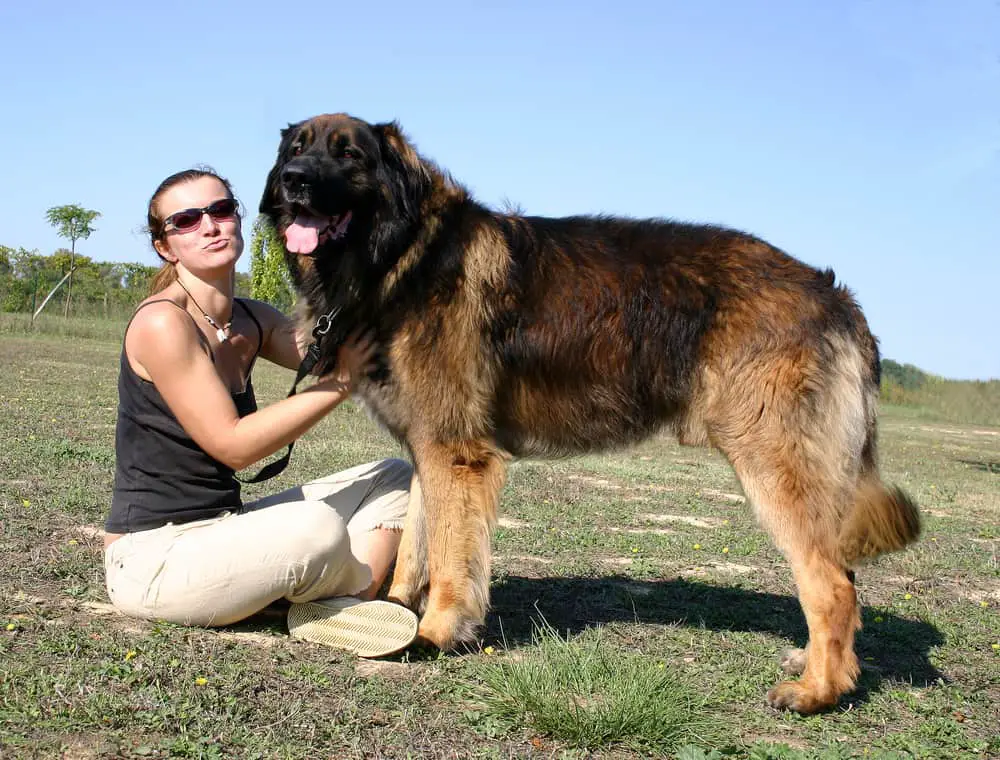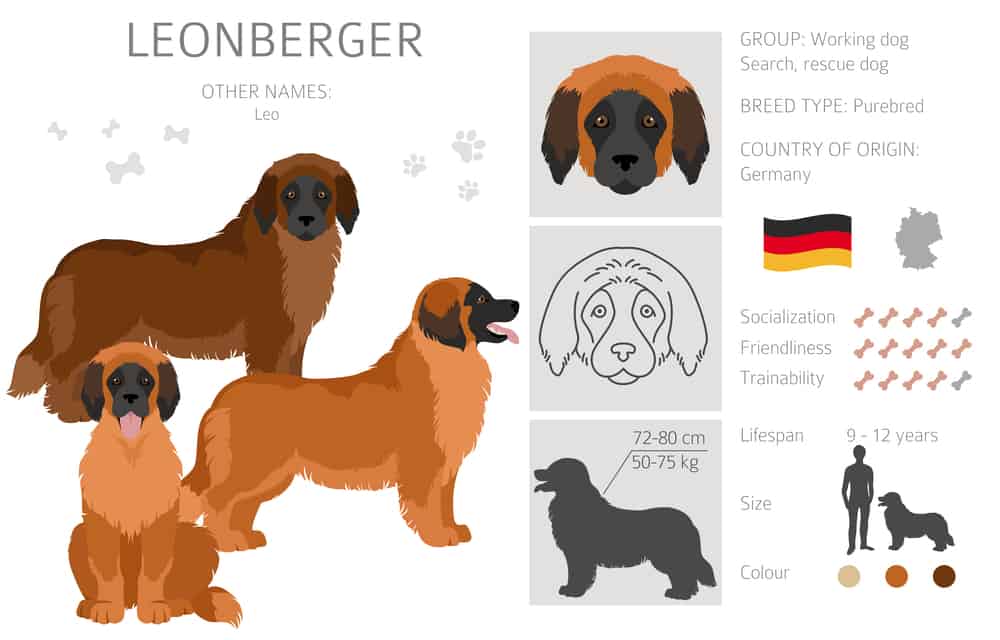Complete Guide To The Leonberger: Health, Grooming, Exercise and More
The Leonberger is among the few giants dogs developed primarily for companionship. Leonbergers, or Leos, were bred from Saint Bernards and Newfoundlands among other large breeds, so it’s no coincidence they share similar traits. Partners to princes, they’re intelligent, high-spirited helpers and devoted family friends.
I’ve seeen a few of these impressive dogs in my veterinary practice over the past decade and I’m honestly surprised that they are not more common (at least in my area where large dogs are very prevalent).
Table of Contents
How Big Do Leonberger Get?
| Height | Weight | |
| Male | 28″ – 31.5″ at the shoulder | 110-170 lbs |
| Female | 25.5″ – 29.5″ at the shoulder | 90-140 lbs |

What Do Leonbergers Look Like?
Leos have medium-length ears that hang flat against their heads. Their tails are long and bushy. The overall impression of this magnificent dog is one of authority and affection.
Colors mimic those in lions:
• Yellow
• Sandy
• Red
• Reddish Brown
Black tips are common but more than minimal white is a disqualification. A black mask is a key characteristic. Over their deep brown eyes, it gives them a thoughtful, sometimes quizzical expression.

What Is The Personality Of A Leonberger?
Leonbergers have as much love in their in hearts as they have hair on their heads — a lot. Eager to please and ready to protect, family is what matters most.
Large and energetic, they need plenty of room to stretch their legs. A country home with a large lot and a secure fence is an ideal setting. They don’t need hours of daily activity, but they’re built for the outdoors and will enjoy keeping you company on jogs or helping with the chores.
Easy to train, Leos are courteous housemates and excellent with children — they’ll find no better companion. But dogs as large a humans need early socialization and training. They don’t know their own strength, so good manners are a matter of safety.

How Much Grooming Do Leonbergers Need?
Leonbergers have thick double coats to protect them from the elements — a downy layer near the skin that helps with thermoregulation and a lush top coat that deflects precipitation. They shed moderately year-round and copiously in the spring and fall. Keep your vacuum on high alert.
Daily brushing is a must to keep a Leo’s coat in top condition. It takes time, but it’s not complicated. A once-over with a slicker or pin brush at the end of the day removes debris and loose hair.
Use a rake once weekly to thin the undercoat and a long-tined metal comb to tease out knots. Tangles are common behind their legs and in the thick mane around their necks.
Leos aren’t known for doggy odor, so with regular brushing, a bath every 4-6 months is usually enough to keep them fresh. Check their ears monthly for symptoms of infection, such as redness and odor.
Leonbergers have cat-like feet with well-arched toes, so their nails should be kept short to avoid discomfort. Trim them every two weeks with a grinding tool — unlike clippers, they leave no rough edges.
How Much Exercise Does A Leonberger Need?
These are meant to be true working dogs so they do need quite a bit of exercise. If you are particularly active or have a large yard or property, a Leonberger would fit in great.
Activities That I Recommend With This Breed:
- Walking
- Hiking (both walking and hiking can be done with your dog also wearing a weighted pack; the weight in the pack will help to tire your dog out faster; don’t do this if your dog has any orthopedic issues)
- Swimming
- Agility Training
- Dog Parks
What Kind of Dog Food Is Good For A Leonberger?
Personally I believe that most foods are fine for most dogs. Some dogs may not do well on some foods. However, as a rule I don’t blanket-prohibit any dietary ingredient from any breed at this time.
This is a breed that requires a large-breed puppy food to help control growth. Growing too fast can cause growing pains and potentially developmental orthopedic issues. For this reason, I recommend to my Leonberger owners to switch to adult food at around 6 months of age.
Best Puppy Food For Leonbergers:
Best Adult Food For Leonbergers:
- Purina Pro Plan Large Breed
- Eukanuba Adult Dry Dog Food
- Nutro Natural Choice Large Breed Adult
- Merrick Classic Healthy Grains Dry Dog Food
Please don’t listen to the folks at the pet store trying to convince you to buy a grain-free diet for your dog. There’s zero science behind that and vets are actually seeing diseases now related to feeding grain-free foods.
It’s very important they remain at their optimal weight throughout their life. Have your vet go over with you exactly where to feel to know when your dog is too big.
How Long Does A Leonberger Live?
On average, about 9 years of age based on information from the AKC
What Health Problems Can Leonbergers Have?
Like any large breed of dog, Leonbergers are more prone to certain orthopedic issues such as:
- Hip Dysplasia
- Elbow Dysplasia
- Arthritis as they age from these issues as well as normal wear and tear
Obesity is a concern as well, especially as they age. Make sure you can feel the ribs on your dog. If you’re not sure, then ask your veterinarian for help in how to spot when your dog is overweight.
Where Can I Find Out More About The Leonberger?
Where Can I Find a Leonberger?
Breeder List From The Leonberger Club of America
Looking for a Rescue? Try Leo Rescue Pals or
Interesting Facts About the Leonberger
Every breed has a noteworthy history, but the Leonberger’s background is more intriguing than most.
Did you know?
• They Were Bred to Look like Lions
Heinrich Essig, German politician, entrepreneur and dog lover, bred the Leonberger to resemble the lion on the town’s crest. He wanted a companion dog fit for royalty, so there was no better model than the “King of the Jungle.” So successful was his effort that Tsar Alexander II and the Prince of Wales both added this noble giant to their courts.
• They’re Relatively Rare in the US
Leonbergers are popular across Europe but remain uncommon in the US, ranking 93rd on the AKC’s list of most popular dogs. Newly recognized in 2010, their numbers, however, are rising as more people learn about this lovable breed.
• Two Breeders Saved Them from Extinction
Conflicts in Europe threatened many breeds over the centuries, and the Leonberger was no exception. Records show their numbers dwindled to 25 by 1922 when Karl Stadelmann and Otto Josenhans rebuilt the line from five top specimens. Four years later, the population flourished, and the breed was well on its way to a secure future.
• They’re Sensitive
Leos are a sensitive breed. They have an innate understanding of people’s emotions and get visibly distraught when there’s conflict in their social group. Not surprisingly, this makes them excellent therapy dogs with a good bedside manner and an ability to comfort the ill.
In 2002, the Leonberger Club of America established an award program to celebrate Leos and their owners for their accomplishments. Over a hundred have been recognized.
• They’re Able-bodied
Leonbergers were bred for the aristocratic life, but they’re also athletic and can be tireless workers. They enjoy a range of activities from swimming to pulling carts, so they’re helpful around the house and participate in many canine sporting events.
• They’re Talented Search and Rescue Dogs
With Saint Bernards as ancestors, it’s not surprising that Leos are excellent search and rescue dogs. Able to take direction, their webbed feet and water-resistant double coats make them especially effective for cold-water missions.
• Leos Are Dimorphic
The males and females among the AKC’s nearly 200 recognized breeds can be difficult to tell apart — not so with the Leonberger. Dimorphic, males are significantly larger with a heavier bone structure and uniquely masculine characteristics. Other dimorphic breeds include the Rottweiler and Belgian Tervuren.
